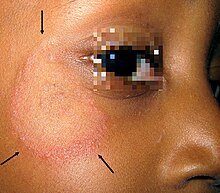Tinea faciei: Difference between revisions
definition |
signs/symps |
||
| Line 22: | Line 22: | ||
| deaths = |
| deaths = |
||
}} |
}} |
||
'''Tinea faciei''' is a [[Dermatophytosis|fungal infection]] of the skin of the face.<ref name="Andrews">{{cite book |last1=James |first1=William D. |last2=Elston |first2=Dirk |last3=Treat |first3=James R. |last4=Rosenbach |first4=Misha A. |last5=Neuhaus |first5=Isaac |title=Andrews' Diseases of the Skin: Clinical Dermatology |date=2020 |publisher=Elsevier |location=Edinburgh |isbn=978-0-323-54753-6 |page=295 |edition=13th |url=https://books.google.com/books?id=UEaEDwAAQBAJ |language=en |chapter=15. Diseases resulting from fungi and yeasts}}</ref> It generally appears as a red rash |
'''Tinea faciei''' is a [[Dermatophytosis|fungal infection]] of the skin of the face.<ref name="Andrews">{{cite book |last1=James |first1=William D. |last2=Elston |first2=Dirk |last3=Treat |first3=James R. |last4=Rosenbach |first4=Misha A. |last5=Neuhaus |first5=Isaac |title=Andrews' Diseases of the Skin: Clinical Dermatology |date=2020 |publisher=Elsevier |location=Edinburgh |isbn=978-0-323-54753-6 |page=295 |edition=13th |url=https://books.google.com/books?id=UEaEDwAAQBAJ |language=en |chapter=15. Diseases resulting from fungi and yeasts}}</ref> It generally appears as a photosensitive painless red rash with small bumps and a raised edge appearing to grow outwards, usually over eyebrows or one side of the face.<ref name="Andrews"/> It may feel wet or have some crusting, and overlying hairs may fall out easily.<ref name="pcds">{{cite web |title=Tinea faciei (face) and barbae (beard) |url=http://www.pcds.org.uk/clinical-guidance/tinea-faciei-face-and-barbae-beard |website=www.pcds.org.uk |access-date=18 September 2021}}</ref> There may be a mild itch.<ref name="Presterl2018">{{cite book |last1=Ginter-Hanselmayer |first1=Gabriele |last2=Nenoff |first2=Pietro |editor1-last=Presterl |editor1-first=Elisabeth |title=Clinically Relevant Mycoses: A Practical Approach |date=2018 |publisher=Springer |isbn=978-3-319-92300-0 |pages=149-150 |url=https://books.google.com/books?id=-nSADwAAQBAJ&newbks=0&printsec=frontcover&dq=Tinea+faciei++prevalence&hl=en |language=en}}</ref> |
||
Tinea faciei is contagious just by touch and can spread easily to all regions of skin.{{Citation needed|date=April 2009}} |
Tinea faciei is contagious just by touch and can spread easily to all regions of skin.{{Citation needed|date=April 2009}} |
||
Revision as of 19:30, 18 September 2021
| Tinea faciei | |
|---|---|
| Other names | Ringworm of the face |
 | |
| Tinea faciei | |
| Specialty | Dermatology |
| Symptoms | Facial ringworm appears as one or more pink-to-red scaly patches which contain bumps, blisters, or scabs.They can be itchy, and it may get worse or feel sunburned after exposure to the sun. |
| Treatment | topical creams and lotions: Terbinafine, Clotrimazole, Miconazole, Econazole, Oxiconazole, Ketoconazole, Sulconazole, Naftifine |
Tinea faciei is a fungal infection of the skin of the face.[1] It generally appears as a photosensitive painless red rash with small bumps and a raised edge appearing to grow outwards, usually over eyebrows or one side of the face.[1] It may feel wet or have some crusting, and overlying hairs may fall out easily.[2] There may be a mild itch.[3]
Tinea faciei is contagious just by touch and can spread easily to all regions of skin.[citation needed]
Treatment
Most infections can be treated with topical antifungal medication. Rarely, more extensive or long-standing infections may require treatment with oral antifungals. The infection will still be contagious between 24-48 hours of the first treatment.
The ringworm should go away within 4–6 weeks after using effective treatment.
This section needs expansion. You can help by adding to it. (February 2019) |
See also
References
- ^ a b James, William D.; Elston, Dirk; Treat, James R.; Rosenbach, Misha A.; Neuhaus, Isaac (2020). "15. Diseases resulting from fungi and yeasts". Andrews' Diseases of the Skin: Clinical Dermatology (13th ed.). Edinburgh: Elsevier. p. 295. ISBN 978-0-323-54753-6.
- ^ "Tinea faciei (face) and barbae (beard)". www.pcds.org.uk. Retrieved 18 September 2021.
- ^ Ginter-Hanselmayer, Gabriele; Nenoff, Pietro (2018). Presterl, Elisabeth (ed.). Clinically Relevant Mycoses: A Practical Approach. Springer. pp. 149–150. ISBN 978-3-319-92300-0.
External links
